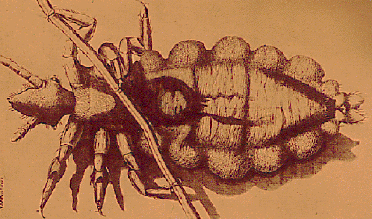Phthiraptera
Lice


The Phthiraptera are the lice; this one, the human head louse Pediculus capitis, was drawn in the seventeenth century by the early microscopist and scientist Robert Hooke. Lice are insects that have secondarily lost their wings and become ectoparasites -- external parasites -- on birds and mammals. Sucking lice (Anoplura), such as the human body louse figured above, have modified mouthparts for piercing and sucking. Others, traditionally grouped in the Mallophaga, are referred to as chewing lice, because their mouthparts are modified for chewing. Phthirapterans show extreme host specialization; in fact, many bird and mammal species can be identified by nothing more than the lice species that live on them, for these lice species would be found nowhere else.
Lice have almost no fossil record; the only ones known have been recovered from frozen mammals in Siberian permafrost, and are about 10,000 years old. Since the Phthiraptera as we know them today are restricted to birds and mammals, lice probably did not come into existence before the Jurassic -- although ancestral Phthiraptera might have fed on the ancestors of birds (dinosaurs!) and of mammals in the Triassic.
For information on human lice and how to treat lice infestation, read this fact sheet created by the New York State Department of Health.
The Department of Entomology at Iowa State University maintains an image gallery that includes pictures of lice. General information on lice, including images, is available as part of an on-line set of course notes in veterinary parasitology at Oklahoma State University.

Carpenter, F.M. 1992. Treatise on Invertebrate Paleontology. Part R: Arthropoda 4. Volume 4: Superclass Hexapoda. Geological Society of America and University of Kansas Press, Lawrence, Kansas.

